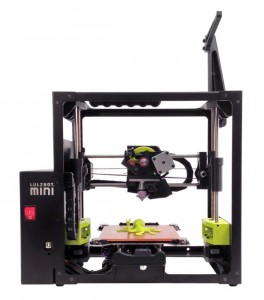
Measuring 17″ x 13.4″ x 15.2″ and weighing a mere 19 pounds, the LulzBot Mini fits nicely on a desktop. Set-up takes about 15 minutes. Just take the printer out of the box, hang the filament, download the software, connect the printer to the PC and start printing. The LulzBot Mini uses open source CAD software and hardware. However, unlike most machines, the printer allows users to operate the device using BotQueue, MatterControl, OctoPrint, Printrun and Slic3r.
Automized Bed Leveling
Leveling the printer bed remains one of the most frustrating aspects of owning a 3D printer. In addition to time-consuming, the task also costs money in the amount of filament wasted until achieving a level platform. However, the revolutionary technology contained within the LulzBot completely eliminates the need for manual adjustments. Similar to CNC routers, the nozzle simply makes contact with each of the four corners of the bed that have a metal washer. As the nozzle tip touches the washer, an electromagnetic sensor calibrates itself according to the Z-axis location.
Polyetherimide Printing Surface
The majority of 3D printers provide a challenge when it comes to getting a printed object to adhere to the print bed. LulzbBot remedied the problem by putting a polyetherimide film over a borosilicate glass bed. When heated, the surface becomes sticky enough to keep the filament in place. Once cooled, the surface mimics a glass, which also makes removing the finished product a breeze. The printer does come equipped with a spatula, a pick and brush for removing printed objects.
Easy Nozzle Replacement
Whether needing to clean or change the nozzle, attempting this feat on some models means the possibility of damaging the heat sensor. On the LulzBot Mini, the nozzle merely wipes clean. Removal is simply done by screwing a nozzle on or off in a matter of seconds. Finding replacements is also a cinch, as the device is designed to use generic replacements, which are available in a variety of sizes.
High Temperature Printing
A variety of 3D printers do not achieve high enough temperatures to accommodate Colorfabb XT or t-glase filaments. These advanced filaments typically require temperatures of around 482 degrees Fahrenheit to prevent air bubble formation. The LulzBot is created to handle temperatures that easily exceed 570 degrees Fahrenheit.
The open reel design also allows the filament to hang from a hook, which makes changing much easier. Conveniently, the printer accepts a number of thermopolymer filaments that include:
* ABS
* HIPS
* PLA
* PVA
* Wood-filled
* PETT
* Bronze and copper filled
* Polycarbonate
* Nylon
* PETG
* Conductive ABS and PLA
* UV luminescent
* PC-ABS and PCTPE
The printer does not have wireless connectivity and must be operated while connected to a PC. The device does not offer onboard storage or have an LED screen to view and change options. Changes must be implemented via the PC and the Cura software. As the metal frame is not enclosed, users can also expect to hear all of the mechanisms during the printing process. Retailing for around $1,350, the price puts the LulzBot in the medium range of 3D printers. However, the accuracy, flexibility and speed of printing processes puts this printer ahead of all competition.

I got 3D printing experience by creating projects at makerspace. I eventually decided to buy my own printer. I chose the LulzBot, because the printer is manufactured in Colorado. The company also offers a 12-month warranty. I am impressed by the durability of the machine. I unpacked the printer and completed my first project 40 minutes later. Most of this time involved learning from the instructions. I simply plugged the printer in, plugged in the USB and installed the filament. I use the printer anywhere from 30 to 40 hours every week, and I have never encountered problems with nozzle clogs. I use either blue tape or the glue stick on the print bed. Projects adhere to the surface when the bed is hot and remove easily when everything cools. I also like the auto-leveling feature. After evaluating reviews on various products, not many provide the same out-of-the-box experience.
I consider myself very qualified to review this printer, I’ve had 3 of them. They all failed for different reasons. I cannot imagine why this 3d printer has so many good reviews. The first one I got couldn’t auto-calibrate and ended up destroying the print-bed. The second one arrived damaged, wouldn’t print in the x-axis. The third one lasted longer – about 10 days – before it went bad. The prints were shifted and the holes were no longer round. After that I was done with Lulzbot.
Great review!! We also tested the Lulzbot Mini and were quite impressed by the overall results we got.